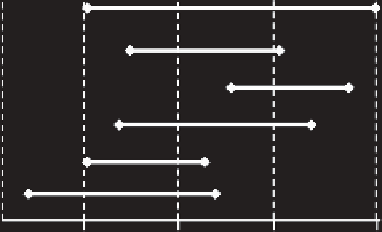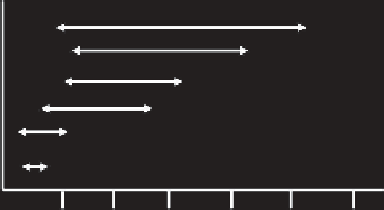Environmental Engineering Reference
In-Depth Information
Functions provided by the three-zone buffer system
Wildlife habitat
Flood reduction
Sediment removal
Nitrogen removal
Bank stability
Shade/food web
Stream
Zone 1
Zone 2
Zone 3
FIGURE 8.42
Zones and functions of a riparian forest buffer. (Redrawn from Palone, R.S. and Todd, A.H.
(eds).,
Chesapeake Bay Riparian Handbook: A Guide for Establishing and Maintaining Riparian Forest
Buffers
, USDA Forest Service, Radnor, PA, 1997.)
future logging. In Zone 3, the transition zone with adjacent land (such as urban areas or agricul-
tural ields), a dense herbaceous cover with no trees or shrubs works well to slow and ilter runoff
(Tjaden and Weber 1997).
A second step in the buffer design is the determination of the design width. The width is based,
in part, on the designated function of the buffer, with the recommended minimum widths illustrated
in Figure 8.43. The NRCS program and criteria for “Riparian forest buffer—terrestrial and aquatic
wildlife habitat” (NRCS 2009) call for the width of forested riparian zones to be at least 2.5 times
the width of the stream channel. Most commonly, for use in water quality and habitat maintenance,
buffer widths are approximately 35-100 ft., where buffers of less than 35 ft. cannot sustain long-
term protection of aquatic resources (Tjaden and Weber 1997). The eficiency of buffers, such as in
nutrient removal, is variable and is dependent on conditions such as where groundwater maintains
saturated soils promoting anaerobic denitriication, so that, in some cases, a narrow strip may be
more effective than a wider strip. However, wider strips tend to be more effective; federally recom-
mended buffer widths vary from about 7 to 100 m (Mayer et al. 2005).
The maintenance and management of buffers must also be included in the design. Weed control
is essential for the survival and rapid growth of trees and shrubs in a buffer (Tjaden and Weber
1997). To maintain the buffer's integrity, it should be protected against (Mayer et al. 2005):
Wildlife habitat
Flood mitigation
Sediment removal
Nitrogen removal
Water temperature moderation
Bank stabilization and aquatic food web
0
50
100
150
200
250
300
Buffer width (ft.)
FIGURE 8.43
Range of minimum widths for meeting speciic buffer objectives. (Redrawn from Palone,
R.S. and Todd, A.H. (eds).,
Chesapeake Bay Riparian Handbook: A Guide for Establishing and Maintaining
Riparian Forest Buffers
, USDA Forest Service, Radnor, PA, 1997.)


Search WWH ::

Custom Search